#transoxiana
Text
The Multiethnic Origins of the Muslim Conquest
The Multiethnic Origins of the Muslim Conquest
Episode 19: Islam and the Caliphates
Barbarian Empires of the Steppes (2014)
Dr Kenneth Harl
Film Review
In this lecture, Harl focuses mainly on the battle for control of the Muslim caliphate following the birth of Islam in the 7th century AD.
The key dates he cites are
622 AD – the prophet Muhammad migrates to Medina from Mecca owing to conflict with Mecca elites.
632 AD – Muhammad dies after…
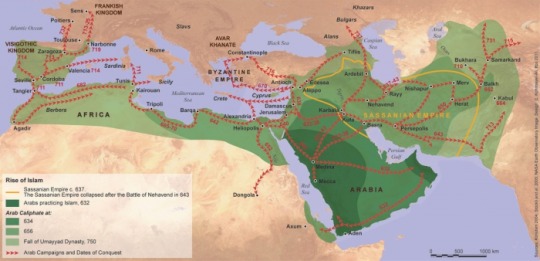
View On WordPress
#abbasid#ali#baghdad#byzantine#caliphate#damascus#egypt#fatima#indus valley#khazars#levant#mecca#media#muhammad#north africa#sassanid empire#shia#transoxiana#turks#umayyad
9 notes
·
View notes
Text
transoxiana? where's Oxiana and how can I meet them
0 notes
Text
The Legend of Sambation River and the Ten Lost Tribes of Israel | Ancient Origins
https://www.ancient-origins.net/myths-legends-asia/sambation-river-0018887
View On WordPress
#1st century#8th century#Anatolia#Armenia#Assyrians#Babylon#Caucasus#China#Islam#Judaeans#Judah#Kazakhstan#King Jeroboam#Levites#Lost Tribes of Israel#Mesopotamia#Moses#Sambation River#Shabbat#Transoxiana#Tribe of Benjamin#Turkmenistan
0 notes
Text


Statue found near Penjikent, possibly depicting Sogdian King Devashtish or a deity 7th-8th C. CE.
"Divashtich (also spelled Devashtich, Dewashtich, and Divasti), was a medieval Sogdian ruler in Transoxiana during the period of the Muslim conquest of Transoxiana. He was the ruler of Panjikant and its surroundings from ca. 706 until his downfall and execution in the autumn of 722.
Divashtich was the son of a certain Yodkhsetak, who belonged to a noble Sogdian dehqan family from Samarkand, which could trace its descent back to the Sasanian king Bahram V Gur (r. 420–438). The family bore the title of sur and began ruling parts of Sogdia during the 6th century. There were five members of the family bearing the title of sur, Divashtich being the last of them.
In 720, Divashtich, along with another Sogdian ruler named Karzanj, are mentioned as the leaders of an anti-Arab rebellion in Sogdia. They managed to earn the allegiance of at-Tar, the Sogdian ruler of Farghana, who promised to give them protection in case their rebellion turned into a failure. While the army of Karzanj was staying at Khujand, at-Tar betrayed him, and told the Umayyad general Sa'id ibn Amr al-Harashi where Karzanj and his army was stationing. Al-Harashi quickly marched towards Khujand, where he defeated the army of Karzanj, brutally massacring over 3,000 Sogdian inhabitants in the city.
Al-Harashi then left for Zarafshan, the location of Divashtich. A battle shortly took place near the city in 722, where al-Harashi managed to emerge victorious once again. Divashtich then fled to a fortress near Zarafshan, but eventually agreed to surrender to Arabs, and was taken prisoner, where he was treated well. The Arabs then began burning several houses and a temple in Panjikant.
The Umayyad governor of Iraq, including other high officials, wanted to set Divashtich free. Al-Harashi, however, had Divashtich crucified on a Zoroastrian burial building, and sent his head to Iraq.
Archaeologists have found evidence that Panjakent was founded around 400 AD. The town of Panjikent grew during the Hephthalite period, its fortifications were strengthened and temples were rebuilt. The city itself did not long outlive its last ruler. Consisting of a fortified castle of the ruler (kuhendiz, or citadel), the city itself (shahristan), surrounded by a fortress wall with numerous towers, a suburban settlement (rabad) and a large necropolis, with separate small crypts - nauses, in which there were assuaries (small clay boxes) with the remains of the dead, Penjikent ceased to exist after the death of Divashtich, and the inhabitants left it."
-taken from IranicaOnline, UNESCO, Wikipedia, and DCAT
#sogdiana#iranian#persian#ancient persia#ancient history#history#antiquities#art#sculpture#museums#statue
88 notes
·
View notes
Text
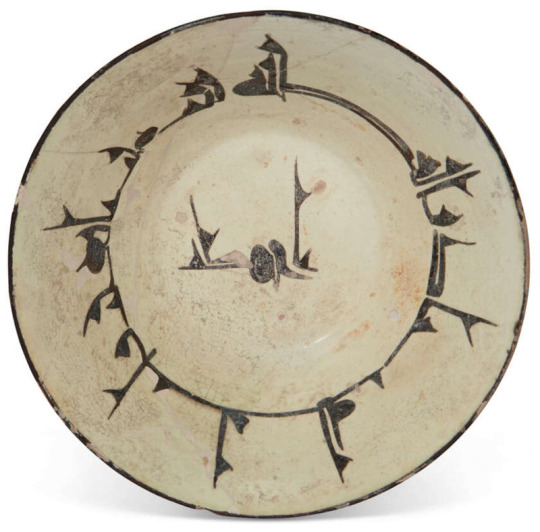
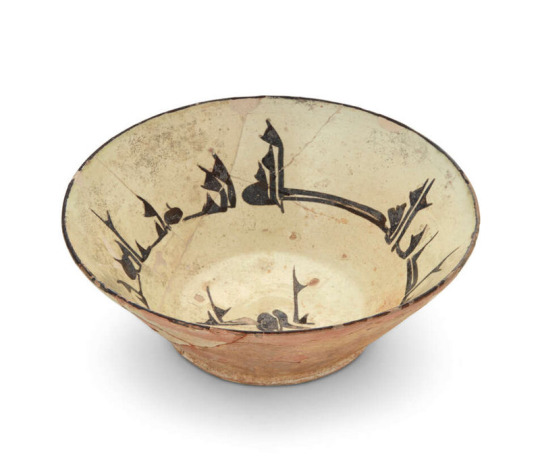
A calligraphic pottery bowl, North East Iran or Transoxiana, 11th century.
Courtesy Alain Truong
54 notes
·
View notes
Text
On the Black Death in Africa and Asia, and the interconnected Middle Ages, by Eleanor Janega
“…See, the thing is that one of the weird myths I have to deal with all the time is that the Black Death was somehow a European experience, as opposed to an Afro-Eurasian one, and that Europeans were uniquely attacked by it because of something stupid/gross/superstitious that they did that everyone else avoided. Sometimes that’s people saying Europeans killed all their cats and so rats proliferated. Sometimes its people saying that Europeans didn’t bathe and therefore germs spread. (Of course, that’s beside the point anyway, because last time I checked fleas, which are what spreads plague, DGAF about how clean you are, but OK! Europeans still bathed! I am so tired!)
Sometimes, it’s people saying that Europeans’ backwards medical ideas involving the humoral system is to blame. (The entire Arabic world also believed in the humoral system! The only thing that works to treat the plague is antibiotics! No one in the entire world had medicine that could fight this until the nineteenth century!) Sometimes its people saying that Europeans threw sewage in the streets. (They didn’t, but I’ll have to talk about that another time. And also! Plague comes from fleas! Which do not live in human excrement anyway! So that’s really beside the point! And even when it’s pneumonic not bubonic it spreads via droplets! Which are in your breath! Not excrement! Oh my god!)
But here’s the thing, if any of that were true, (and it isn’t) that would mean that the theoretically smarter rest-of-the-world wouldn’t be affected by the Black Death at all because they were having a bath with their cat next to a fully piped sewage system while not believing in humoral theory or something.
Fun fact! No.
Now we might not have a lot of sources from the totally collapsed Silk Road cities, etc., but we do have a lot from our friends in the Middle East. And they are here to tell you that everyone was having a hard time, and they had a pretty clear idea of how the plague spread.
The historian Ibn al-Wardī (c.1291 – 1349), writing in Aleppo described the onslaught of the plague thusly:
“The plague frightened and killed. It began in the land of darkness [Northern Asia]. Oh what a visitor! It has been current for fifteen years. China was not preserved from it, nor could the strongest fortress hinder it. The plague afflicted the Indians in India. It weighed upon the Sind. It seized with it’s hand and ensnared even the lands of the Uzbeks. How many backs did it break in what is Transoxiana! The plague increased and spread further. It attacked the Persians, extended its steps toward the land of the Khitai, and gnawed away at the Crimea. It pelted Rum with live coals and led the outrage to Cyprus and the islands. The plague destroyed mankind in Cairo. Its eye was cast upon Egypt, and behold, the people were wide-awake.”
“… Oh Alexandria, this plague is like a lion which extends its arm to you. Have patience with the fate of the plague, which leaves of seventy men only seven. … The plague attacked Gaza, and it shook ‘Asqalan severyly. The plague oppressed Acre. The scourge came to Jerusalem … It overtook those people who fled to the al-‘Aqsa Mosque, which stands beside the Dome of the Rock. If the door of mercy had not been opened, the end of the world would have occurred in a moment. It, then, hastened its pace and attacked the entire maritime plain. The plague trapped Sidon and descended unexpectedly upon Beirut, cunningly. Next, it directed the shooting of its arrows to Damascus. There the plague sat like a king on a throne and swayed with power, killing daily one thousand or more and decimating the population.”[6]
He died of the plague.
Later, writing in Algeria, the historian Ibn Khaldûn (1332-1406) said of the pestilence that “It swallowed up many of the good things of civilization and wiped them out. It overtook dynasties at the time of their senility, when they had reached the limit of their duration. It lessened their power and curtailed their influence. It weakened their authority. Their situation approached the point of annihilation and dissolution. Civilization decreased with the decrease of mankind. Cities and buildings were laid waste, roads and way signs were obliterated, settlements and mansions became empty, dynasties and tribes grew weak. The entire inhabited world changed. The East, it seems, was similarly visited, though in accordance with and in proportion to (its more affluent) civilization. It was as if the voice of existence in the world had called out for oblivion and restriction, and the world had responded to its call. God inherits the earth and all who dwell upon it. … it is as if the entire creation had changed and the whole world been altered”.[7]
So, this is all very depressing, but I think it’s important that I lay this all out here for everyone’s perusal. Because the thing is until we begin to approach the medieval world as an interconnected place, weird myths are going to persist. As a Europeanist I am as guilty as anyone of aiding those who want to create a world where the Black Death is a phenomenon that happened on one continent to a group of uniquely stupid people. If no one sees the sources where our friends in Asia and Africa discuss the horrors around them, then of course they are going to continue to believe that the Black Death is something that happens when the Pope takes a disliking to cats. Or something.
I’m not writing this, however, just to defend Europe. I checked, these people are all dead and probably fine. I’m writing it because persisting with the myth that everywhere other than Europe was actually an enlightened paradise does a major disservice to those histories as well. Whole communities collapsed. Death was everywhere. The historians who wanted you to understand the chaos and pain happening all around them died of that plague and if we don’t witness that, then it’s for nothing.
Further, to pretend that only idiots couldn’t figure out that this pestilence was spread by germs in fleas is actually calling all our friends in Africa and Asia stupid as well. Because they also didn’t have germ theory, and they also died in huge numbers. This does not make them foolish.
We can’t go back in time and save the hundreds of millions of people who died of the Black Death in Afro-Eurasia. What we can do from our safe distance of almost seven hundred years, behind a wall of antibiotics, is to at least do them the service of acknowledging their experience and not calling them stupid. These were real people who lived in a complex world and were doing their best in it. Frankly, if you chose to ignore their suffering and their own testaments to it, then you are the one who is ignorant.
Societies are not a hierarchy, and we don’t need to impose one. We certainly don’t need to go back in time to do that either. Ideas of a divided medieval world where people from different continents were all separate and doing totally different things do nothing but serve to uphold outdated and racist ideas of the pre-modern world. Don’t do that in a rush to condemn Europe for its modern problems.”
28 notes
·
View notes
Text
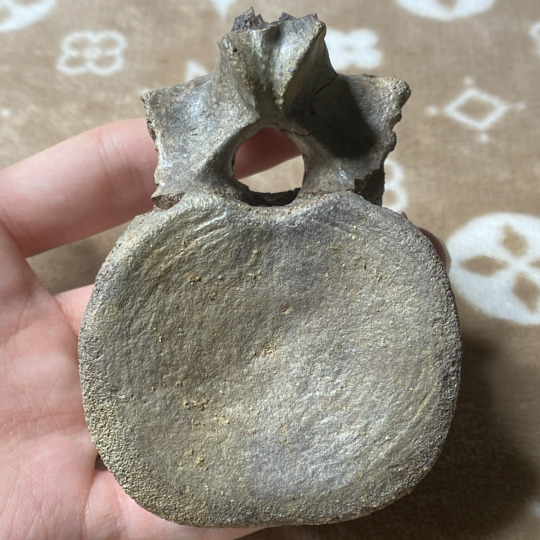
A fossilized vertebra of a Levnesovia transoxiana from the Bissekty Formation in Dzharakuduk or Uchkuduk, Kyzylkum Desert, Uzbekistan. This early diverging hadrosauromorph belongs to a group that includes the famous "duck-billed" dinosaurs. This relatively small hadrosaur was likely prey for the basal pantyrannosaur Timurlengia and the large theropod Ulughbegsaurus.
#dinosaur#fossils#paleontology#palaeontology#paleo#palaeo#levnesovia#hadrosaur#ornithopod#ornithischian#cretaceous#mesozoic#prehistoric#science#paleoblr#レヴネソヴィア#ハドロサウルス科#恐竜#化石#古生物学
15 notes
·
View notes
Text
Submitted via Google Form:
How big can a desert oasis be? I know the Nile river delta is massive but how much bigger can it get? I'd like to have one half the area of Egypt. What also needs to be done about the rivers that flow into them?
Tex: An oasis has a geological underpinning that is man-made in its longevity (Wikipedia), so I suppose they’re only as large as they need to be. Some factors in that include amount of irrigation, size of the underlying water table, how long you can travel from one oasis to another before running out of water, and mode of transportation that typically dictates rate of travel.
By definition, an oasis resides in a desert. If something is large enough to cover, as you say, half of Egypt, then the resulting changes in the local environment might create a temperate climate rather than an arid one. Rivers are part and parcel with sedimentary or metamorphic rocks because of its more porous nature than igneous rock, and are the surface-visible part of water movement that also works underground through things like water tables/aquifers.
Licorice: Apparently the largest oasis in our world is 33 square miles. It has four cities and 22 villages. It's in Saudi Arabia and it's called Al-Ahsa. Al-Ahsa_Oasis (Wiki)
I think it might all be a question of scale. An oasis half the size of Egypt wouldn’t be an oasis in the Sahara desert, but if your desert took up half your planet, then that huge oasis might be considered an oasis.
Utuabzu: The exact definition of oasis gets a little fuzzy, since it’s not super clear at what point your lake becomes an inland sea. But an oasis is typically a body of water formed by upwelling groundwater - generally from an artesian basin of some kind - in an otherwise arid environment. They can range in size from a glorified puddle to the one Licorice mentioned, and they’re not necessarily permanent features on the landscape. Plenty of oases are seasonal, only present when the groundwater has risen due to rains elsewhere and vanishing again once the water table drops.
You mentioned the Nile Delta, which is not an oasis. I suspect you may have meant the Fayum, which is a body of water formed by a branch of the Nile entering an endorheic basin - a watershed that cannot empty to the sea because it is too high on all sides - and has been and remains a very agriculturally productive region of Egypt. Endorheic basins can also produce what are called inland deltas, where a river fans out into a large wetland at the bottom of the basin, as it is unable to reach the sea and does not have high enough water flow to flood the basin and create a lake or inland sea. Examples of this include the Okavango Delta in Botswana and the Sistan Delta in Iran and Afghanistan. More commonly endorheic basins have lakes (often salt lakes) or saltpans at their lowest points, and small or intermittent to non-existent waterways.
If we take what you want to be a region approximately the size of Egypt with a river that ends in a delta but does not flow into the sea, surrounded by desert, then that is possible. The Syr Darya and Amu Darya rivers flow through the Central Asian deserts and steppe to empty into the Aral Sea, which is an endorheic basin that once housed an enormous freshwater lake.* The region between these two rivers - called Transoxiana in classical sources - has been home to a chain of vibrant, prosperous civilisations and a vast diversity of peoples and cultures. So if you want to have a big river run through a desert and empty either into a lake or an inland delta, so long as you know where the water is coming from - the Syr Darya and Amu Darya are fed by snowmelt from the Hindu Kush and Tian Shan mountains, while the White Nile, which is the source of the Nile floods, rises in the Ethiopian Highlands and is fed by the wet season rains there - then there’s really no reason why you shouldn’t. Far stranger things exist in real life.
*Soviet hydroengineering has resulted in the Aral Sea all but drying up, causing immense ecological damage to Central Asia.
14 notes
·
View notes
Text
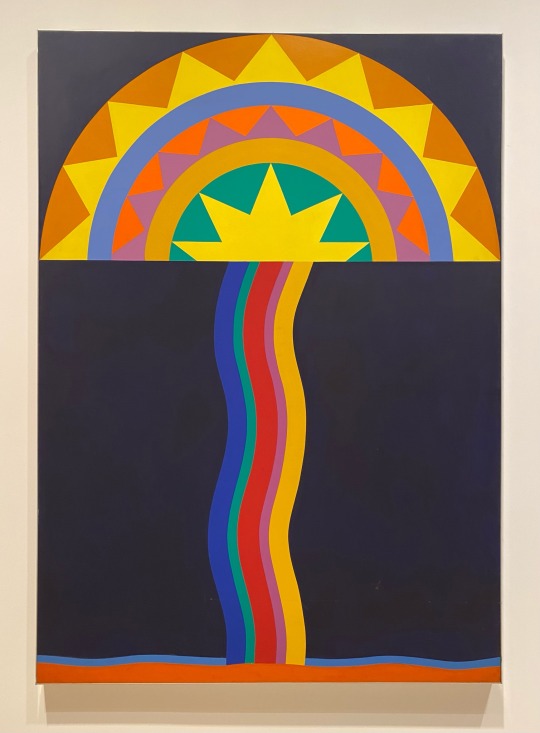
“Transoxiana 9” by Sydney Ball (1968)
17 notes
·
View notes
Photo

The Shibanid (Shaybanid) Conquests, 1500-1510.
by u/Swordrist
This is my attempt at covering an underapreciated area of history which gets next-to no coverage on the internet. Here's some historical context for those uneducated about the region's history:
Grandson of the former Uzbek Khan, Abulkhayr, Muhammad Shibani (or Shaybani) was a member of the clan labeled in modern historiography as the Abulkhayrids, who were one of the numerous tribes which were descended from Chingis Khan through Jochi's son, Shiban, hence the label 'Shibanid' which is used not only in relation to the Abulkhayrids who ruled over Bukhara but also for the Arabshahids, bitter rivals of the Abulkhayrids who would rule Khwaresm after Muhammad Shibani's death and for the ruling Shibanid dynasty of the Sibir Khanate.
After his grandfather's death in 1468, Shibani's father, Shah Budaq failed to maintain Abulkhayr's vast polity in the Dasht i-Qipchak, as the tribes elected instead the Arabshahid Yadigar Khan. Shah Budaq was killed by the Khan of Sibir and Shibani was forced to flee south to the Syr Darya region when the Kazakhs returned and proclaimed their leader, Janibek, Khan. Shibani became a mercenary, serving both the Timurid and their Moghul enemies in their wars over the eastern peripheries of Transoxiana. After the crushing defeat of the Timurid Sultan Ahmed Mirza, Shibani succeeded in attracting a significant following of Uzbeks which formed the powerbase from he launched his conquests.
Emerging from Sighnaq in 1499, Muhammad Shibani captured Bukhara and Samarkand in 1500. In the same year he defeated an attempt by Babur (founder of the Mughal Empire) to take Samarkand. Over the course of the next six years, Shibani and the Uzbek Sultans conquered Tashkent, Ferghana, Khwarezm and the mountainous Pamir and Badakhshan areas. In 1506, he crossed the Amu-Darya and captured Balkh. The Timurid Sultan of Herat, Husayn Bayqara moved against him however died en-route and his two squabbling sons were defeated and killed. The following year he crossed the Amu-Darya again, this time vanquishing the Timurids of Herat and Jam and subjugating the entirety of Khorasan east of Astarabad. In 1508, he raided as far south as Kerman and Kandahar, however he moved back North and launched two campaigns against the Kazakhs, but the third one launched in 1510 ended in his defeat and retreat to Samarkand at the hands of Qasim Sultan.
The Abulkhayrid conquests heralded a mass migration of over 300 000 Uzbeks to the settled regions of Central Asia from the Dasht i-Qipchak. They heralded the return of Chingissid political tradition and structures and the end of the Persianate Timurid polities which had dominated the region for the last century. It forever after changed the demographic of the region. His reign was also the last time Transoxiana was closely linked with Khorasan, as following the shiite Safavid conquests the divide between the two regions would grow into a permanent one.
In 1510, Shibani faced his end when he moved to face Ismail Safavid, who was making moves on Khorasan. Lacking the support of the Abulkhayrid Sultans, who blamed him for their defeat against the Kazakhs earlier that year, he faced Ismail anyway, where he was defeated, killed and turned into a drinking cup.
Shibani's death caused a complete reversal of the Abulkhayrid fortunes. Khorasan and the rest of his empire fell under Safavid dominion. However in Khwaresm, Sultan Budaq's old rivals the Arabshahids expelled the qizilbash and founded their own Khanate, based first in Urgench and then Khiva. In Transoxiana, Babur lost the support of the populace when he announced his conversion to Shiism and his loyalty to Shah Ismail, which allowed the Abulkhayrids to rally behind Shibani's nephew, Ubaydullah Khan and expel the Qizilbash. Nonetheless, the Abulkhayrids would never again hold as much power as they briefly did when led by Muhammad Shibani Khan.
39 notes
·
View notes
Text
Black Legionnaire who has a secret.
He used to have a giant crush on Magnus the Red, back when he was a Terran child in Transoxiana. The Achaemenid Empire produced the Thousand Sons, so by extension all the former Achaemenid territories were gripped by Thousand Sons mania, like it was a sports team to cheer for.
The Black Legionnaire's parents got him a Magnus pillow and Thousand Sons wall calendar and he went to sleep thinking about Magnus' big red butt.
But once it became time to become a Space Marine, he was sorted into the Luna Wolves due to his personality. He was disappointed at first, thinking Magnus was way dreamier than Horus. But once he caught a glimpse of Horus and experienced the Primarch's charismatic aura, he forgot all about Magnus.
It was fortuitous to land in the Luna Wolves, for he had no psychic powers and would have gotten dusted by Ahriman's Rubric had he gotten what he originally wanted.
Meanwhile, his parents saved his Thousand Sons memorabilia after he left, holding it safe for decades, wondering if he would ever return to Terra...
6 notes
·
View notes
Text
The Role of the Silk Road in Creating the First Global Economy
The Role of the Silk Road in Creating the First Global Economy
Episode 8 Trace Across the Tarim Basin*
Barbarian Empires of the Steppes (2014)
Dr Kenneth Harl
Film Review
Between the 2nd century BC and the 2nd century AD, the Silk Road enabled the development of the first “global economy.” The West’s desire for Chinese silk was the primary driver of the Silk Road trade.
Harl traces the five main routes Silk Road traders took from China:
The most northern…
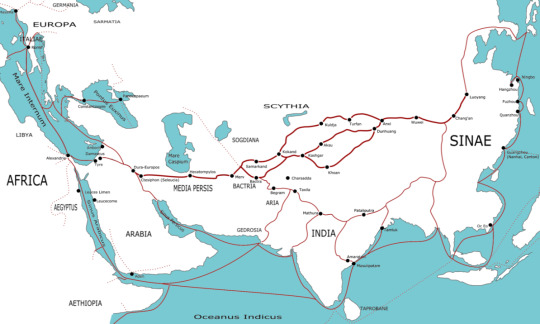
View On WordPress
5 notes
·
View notes
Photo

Timurid column capital with stylized vegetal decoration, Transoxiana, late 14th/early 15th century
128 notes
·
View notes
Text
"I am powerful in Borsippa, I am a hierodule in Uruk, I have heavy breasts in Daduni, I have a beard in Babylon, still I am Nanaya"
—Hymn to Nanaya (Neo-Assyrian) from "Nanâ, the Sumero-Akkadian Goddess of Transoxiana," in Journal of the American Oriental Society by G Azarpay
🏳️⚧️ More about The Gods & Gender
🏳️🌈Sumerian Gods for LGBTQ Issues
10 notes
·
View notes
Text
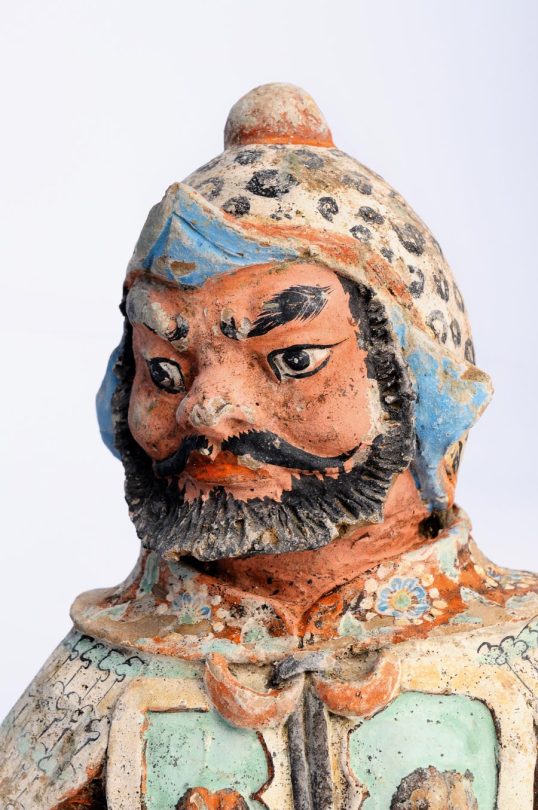
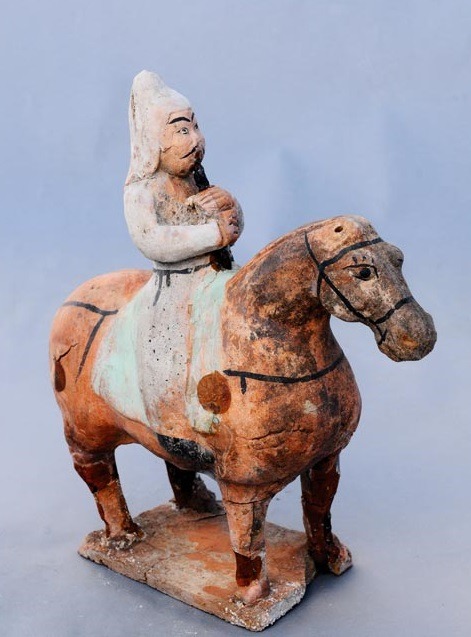

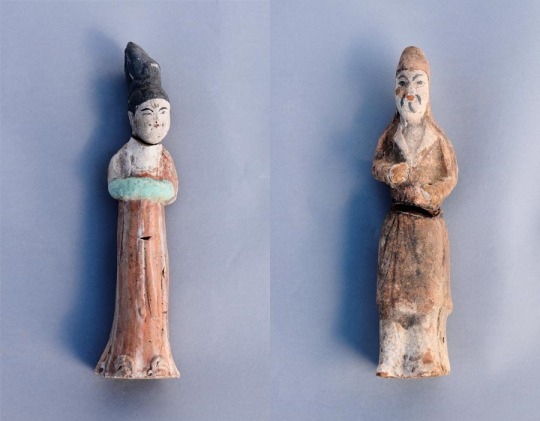


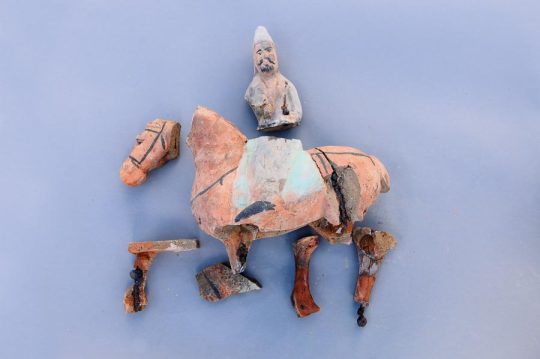
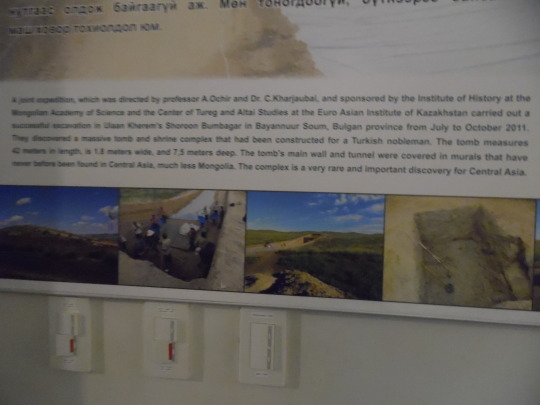




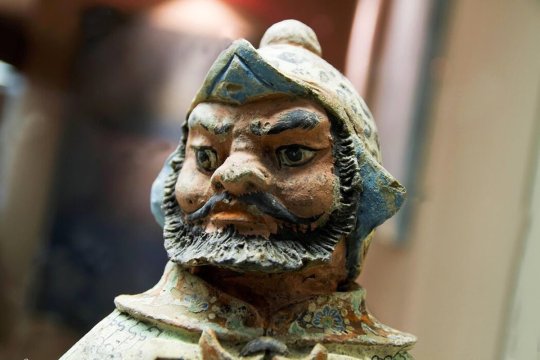
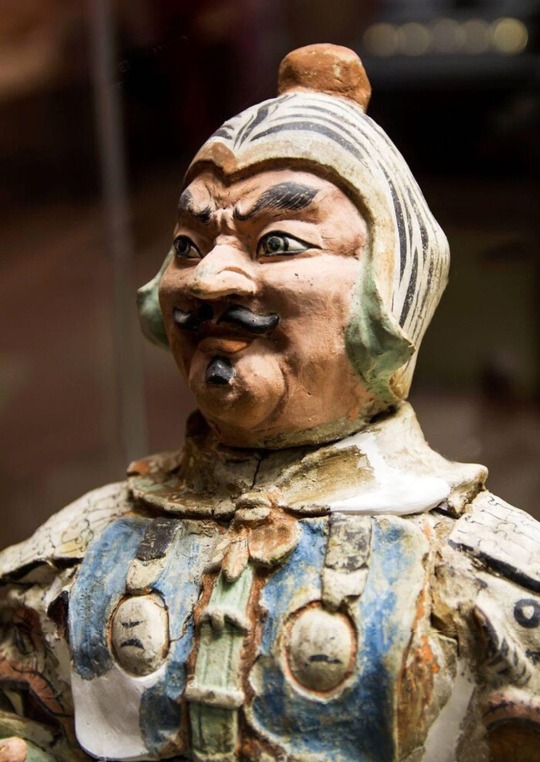
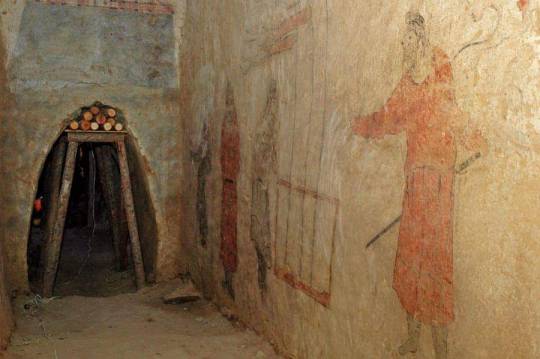

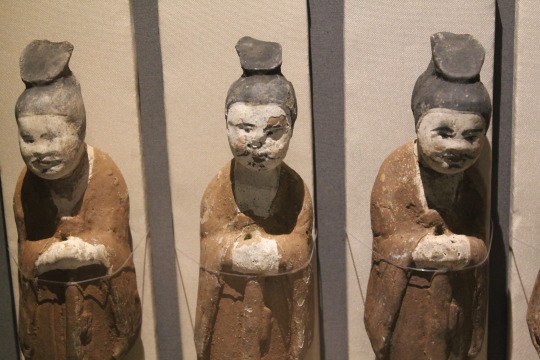

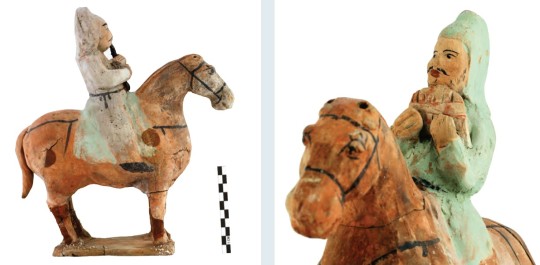

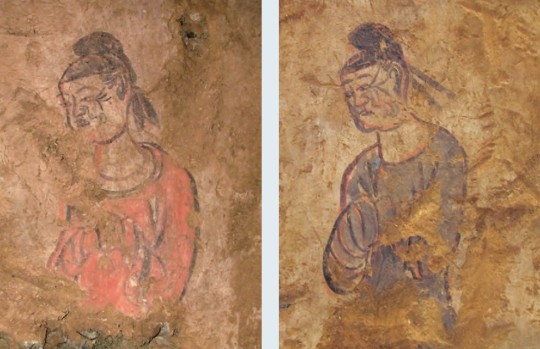


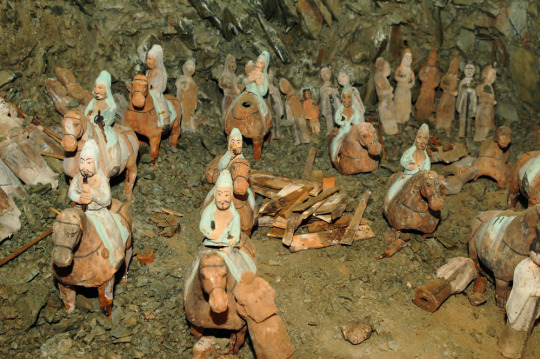





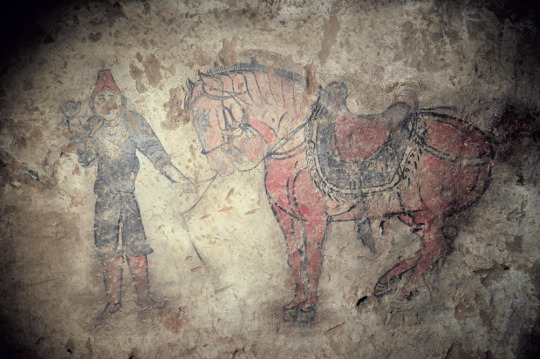
Shoroon Bumbagar, tomb of a Turkic (Gokturk) nobleman, 650-700 CE
"Like Chinese historians, Muslim writers in general depict the ‘Turks’ as possessing East Asian physiognomy. For instance, Sharaf al-Zamān Tāhir Marvazī describes them as being ‘short, with small eyes, nostrils, and mouths’ (1942: 53–4, 156). Similarly, Tabarī (d. 923) depicts the ‘Turks’ as being ‘full-faced with small eyes’ (1987: 21). In his Qābūs-nāma, the eleventh-century Ziyarid ruler Kai Kā'ūs also describes the ‘Turks’ as possessing ‘a large head (sar-i buzurg), a broad face (rūy-i pahn), narrow eyes (chashmhā-i tang), and a flat nose (bīnī-i pakhch), and unpleasing lips and teeth (lab va dandān na nīkū)’ (Kai Kā'ūs ibn Iskandar 1951a: 103; 1951b: 64). The Arab historian and geographer al-Mas'ūdī (896–956) writes that the Oghuz Turks residing in Yengi-kent, a town near the mouth of the Syr Darya, ‘are distinguished from other Turks by their valour, their slanted eyes, and the smallness of their stature’ (wa hum ashadd al-Turk ba’san wa aqsaruhum wa asgharuhum a‘yunan wa fī al-Turk man huwa aqsar min hā’ulā’) (al-Mas'ūdī 1962–: Vol. 1, 212). However, Muslim writers later differentiated the Oghuz Turks from other Turks in terms of physiognomy. Rashīd al-Dīn writes that ‘because of the climate their features gradually changed into those of Tajiks. Since they were not Tajiks, the Tajik peoples called them turkmān, i.e. Turk-like (Turk-mānand)’ (Rashīd al-Dīn Fażlallāh Hamadānī 1988: Vol. 1, 35–6; Rashiduddin Fazlullah 1998–99: Vol. 1, 31). Hāfiz Tanīsh Mīr Muhammad Bukhārī (d. c. 1549) also relates that after the Oghuz came to Transoxiana and Iran, their ‘Turkic face did not re-main as it was’ (1983: fol. 17a (text), Vol. 1, 61 (trans.)). Abū al-Ghāzī Bahadur Khan similarly writes that ‘their chin started to become narrow, their eyes started to become large, their faces started to become small, and their noses started to become big’ after five or six generations (Abu-l-Gazi 1958: 42 (text), 57 (trans.); Ebülgazî Bahadir Han 1975: 57–8). As a matter of fact, the mixed nature of the Ottomans, belonging to the Oghuz Turkic group, is noted by the Ottoman historian Mustafā Ālī (1541–1600). In his Künhü'l-ahbār, he remarks that the Ottoman elites of the sixteenth century were of mostly of non-Turkic origin: ‘Most of the inhabitants of Rum are of confused ethnic origin. Among its notables there are few whose lineage does not go back to a convert to Islam …’ (Ekser-i sükkān-i vilāyet-i Rūm meclis-i muhtelit ul-mefhūm olub ā‘yānında az kimsene bulunur ki nesebi bir müslüm-i cedīde muntehī olmaya) (Fleischer 1986: 254; Mustafā Ālī, Künhü'l-ahbār 1860–68: Vol. 1, 16)."
-Joo-Yup Lee & Shuntu Kuang, A Comparative Analysis of Chinese Historical Sources and Y-DNA Studies with Regard to the Early and Medieval Turkic Peoples
77 notes
·
View notes
Text
Andrei Rubliov al lui Tarkovski . Pe youtube la hi-res. Merită revăzut din când în când. Genială frescă istorică. Asediul orășelului rusesc de către tătari (din partea a 2a), cu ajutorul trădării unui creaz rus este poate cea mai realistă de gen. Fără să apeleze la artificii cinematografice pentru creșterea dramatismului, masacrarea localnicilor și distrugerea orășelului are o incredibilă scară umană... Chiar pornirea la atac începe cu o veselie nemaipomenită din partea liderului tătar. Parcă e un reportaj din epocă... Cu atât mai fascinantă este scena următoare, de iarnă, în care un alt grup de războinici tătari apar în curtea mânăstirii unde trăia Rubliov, foarte veseli și deloc puși pe harțag. Chiar trezesc simpatia unei rusoaice pe care unul din ei o ia cu el să-i fie nevastă. De remarcat atenția deosebită la echipamentul militar și la decoruri. NU mai zic de episodul turnării clopotului. Sunt de savurat fiecare secnă. Atâta atenție pentru detaliu eu n-am văzut în multe filme...Ireproșabile Filosofia ”mesterul Manole”. Iar cruzimea nu era epică.. Aproape nici tragică.. Era firească ca respiratul https://www.youtube.com/watch?v=4JpnrdEOAcM
Tătarii din Hoarda de Aur, din Crimeea erau mongoli sadea. Hoarda de Aur s-a format din resturi ale mongolilor din 1240 care nu s-au mai întors în Mongolia după ce au devastat Rusia si Europa. Si acolo au rămas până când i-a deportat Stalin mai pe toți. Nici vorbă ca tătarii din Crimeea să fie urmași de cumani sau alți turanici. S-or fi corcit cu alte neamuri de stepă din zonă, dar baza e mongolă. La un moment dat tătarii au trecut la Islam. După acest moment au început să folosească limba turcă...Vezi aici mai multe https://en.wikipedia.org/wiki/Golden_Horde Mi se pare stupid să spui ”Ce dovezi există că tătarii crimeeni ar fi fost mongoloizi?” când tătarii rămași azi încă în zonă sunt genetic mult mai apropiați de strămoșii lor din Orientul îndepărtat decât alte neamuri turanice, urmași de avari, cumani, pecenegi ce-si au originea în Asia Centrală, cu mult înaintea apariției mongolilor în zonă. Un exemplu care doar aparent e în favoarea teoriei tale e marele războinic Timur lenk-Tamerlan, căruia i s-au făcut studii antropologice în anii 40 (pe scheletul lui). S-a dovedit că era un metis între mongol și populația caucaziană din Transoxiana (Azerbaigean, Uzbekistan). Totusi, ai dreptate într-o oarecare măsură. Dar ca aspect tătarăă sunt foarte mongoloizi. Adica la fel ca si uzbecii sau turkmenii http://www.iccrimea.org/reports/genographic-results.html
Ai vazut scena cu tatarii din curtea manastirii și fata blondă, iarna? Parcă e reportaj. Fascinant cum îî ignorau pe călugări și se distrau hrănind câinii cu carne de cal... Ai început cu partea 1 a filmului? E cam lentă si monotonă . Partea a 2-a e mult mai dinamică si mai faină. nu conteaza ordinea. Caci povestea e doar vag liniară. Fiecare capitol are valoare independent.
-----------------------------------------
Unul din cele mai bune articole despre ortodoxie pe care le-am citit. Un articol cu niste teme care m-au preocupat de mult timp. Care e problema cu Biserica ortodoxa (greaca, rasariteana) ? Inainte de a te scandaliza, dragă cetitorule, fi înţelept şi aruncă--ţi ochii un pic.
" ...Mai ales ca in viziunea ortodoxa, preotul este legatura, intermediarul intre oameni si Dumnezeu si singurul in masura care sa ii interpreteze cuvantul pentru semenii lui. Un lucru periculos daca avem in vedere ca preotilor romani de-a lungul Evului Mediu si chiar si in epoca moderna timpurie le lipsea stiinta de carte. Ei se multumeau cel mult cu memorarea mecanica a Bibliei si mai important, a traditiilor bisericesti, negasind necesar sa reflecte asupra lor...
Daca in Occident, stiinta a crescut la sanul Bisericii Catolice, ortodoxismul a reprezentat o piedica, deoarece intr-o lume in care totul ramane constant si ramane vesnic acelasi, nu exista nevoie de schimbare. Din aceasta cauza, nu biserica ortodoxa, dar carturarii greco-catolici ai Scolii Ardelene, educati in scolile catolice ale Occidentului au produs cel mai mare act de transformare culturala pe care l-a cunoscut acest popor. Ei au reprezentat motorul trezirii unei constiinte romanesti si cei care au condus primii lupta de emancipare a romanilor. Lor le datoram multe dintre reperele culturale pe care astazi le consideram caracteristice. https://ziare.com/social/religie/ortodoxismul-romanesc-motivul-inapoierii-noastre-opinii-1340383?
>> Ca unul caruia ii place istoria, am simtit de multi ani ca ortodoxismul are ceva vina in ramanerea in urma a romanilor (a unora, caci la greco-catolici se vede schimbarea). Cu timpul am colectat numeroase informatii istorice legate de retardul cultural, educational si implicit social motivat de filosofia ortodoxismului. Numai ca tipul asta a construit un articol coerent in care a adunat in cateva cuvinte esenta acestei proibleme.
>>>Omul nu poate trai fara religie. E fapt dovedit. Dar trebuie ca aceasta Religie sa faca bine omului nu doar sa ZICA ca face bine.. Omului de azi. Nu celui din evul mediu.
>>>>sasii aveau scoli si inaintea reformei lutherane. Majoritatea bisericilor sasesti aveau scoli pe langa inca din sec 15... Lutheranismul a catalizat mai dihai acest trend deja existent. Nu stiu daca de vina era catolicismul sau spiritul intreprinzator al sasilor
>>>>Articolul nu e scris de un teolog, dar chiar daca nu e perfect documentat atinge cateva adevaruri de necontestat. Si intr-un mod in care nu s-a mai spus, desi multi dintre noi am simtit, dar nu am stiut de ce. Inca din evul mediu, de la Sf Grigore Palamas (http://ro.wikipedia.org/wiki/Grigore_Palamas ) , biserica "greaca" a fost preocupata exclusiv de apropierea cat mai mare de divinitate prin isihasm, rugaciune( http://ro.wikipedia.org/wiki/Isihasm ) , izolare, umilinta, suferinta, dispret fata de om, de cunoasterea lumii inconjuratoare. Fiindca, spuneau ortodocsii, Dumenzeu nu poate fi descoperit prin Cunoastere, in sens de Stiinta, Educatie etc...Varlaam Calabrezul (care reprezinta oarecum atitudinea bis vestice http://ro.wikipedia.org/wiki/Varlaam_Calabrezul ) in disputa acestuia cu mai sus-numitul Sf.Grigore spune ca dimpotriva, pt a-l cunoaste pe Dumnezeu trebuie sa studiezi lumea, stiintele, sa te educi. Asta e in esenta diferenta intre orientul ortodox si vestul catolic/protestant. Pt doritori de teologie un articol interesat (chiar daca tine-evident-partea ortodoxiei) http://ziarullumina.ro/.../controversa-isihasta-sau-cum... . E bine sa intelegem de ce bis ortodoxa are o gandire perdanta in lumea de azi, iar filosofia ei, predata copiilor nu duce la nimic bun. Doar la perpetuarea intolerantei, suficientei, atitudinii anti-Stiinta, Anti-Educatie, a resemnarii si umilintei, si a multot alte tare....
------
Înţeleg că nu vă pasă dacă această confesiune a îmbunătăţit în vreun fel viaţa credincioşilor şi dacă o face în prezent. Nu stiu in ce fel iti face viata mai buna faptul ca o data botezat esti crestin (adica cum?) pana mori...
---------
Nu te lăsa păcălit de faptul că ortodoxia nu a avut Inchiziţie sau Cruciade. Întâi, grecii, bulgarii, sarbii, rusii nu au putut sau nu a avut ocazia sa se foloseasca mai mult de religie in politica lor. Cand au putut n-au ratat ocazia. Imp Bizantin s-a luptat cât a putut împotriva musulmanilor. Acele războaie le poti asimila cruciadelor. Ca şi cele la târzii la care au participat şi principii români( ex Cruciada de la Varna). Inchiziţie nu au avut ortodocsii, e drept. Fiindca nu au avut nevoie. Ortodoxia nu a avut universitati sau academii de unde sa apara intelectuali care sa puna in balanta "adevarurule" religioase. Tarile ortodoxe au fost pana mai ieri preponderent rurale, sufocate de superstitii pagane, cu preoti majoritar analfabeti. Ce tribunal s-ar fi apucat sa curete satele rusesti sau sarbesti, bulgaresti sau grecesti (aflate sub otomani) de "vrajitorii si superstitii"? Desi cred ca pe vremea lui Ivan cel Groaznic, la Moscova, nu ai fi fost tratat cu toleranţă dacă ai fi fost acuzat de vrăjitorie...(Recomand filmul "Ţarul" ca fresca a unei tari ortodoxe in Evul Mediu... Ca o completare la Andrei Rubliov, muult mai bun). Sa nu idealizam ortodoxia!!
---------
6 notes
·
View notes